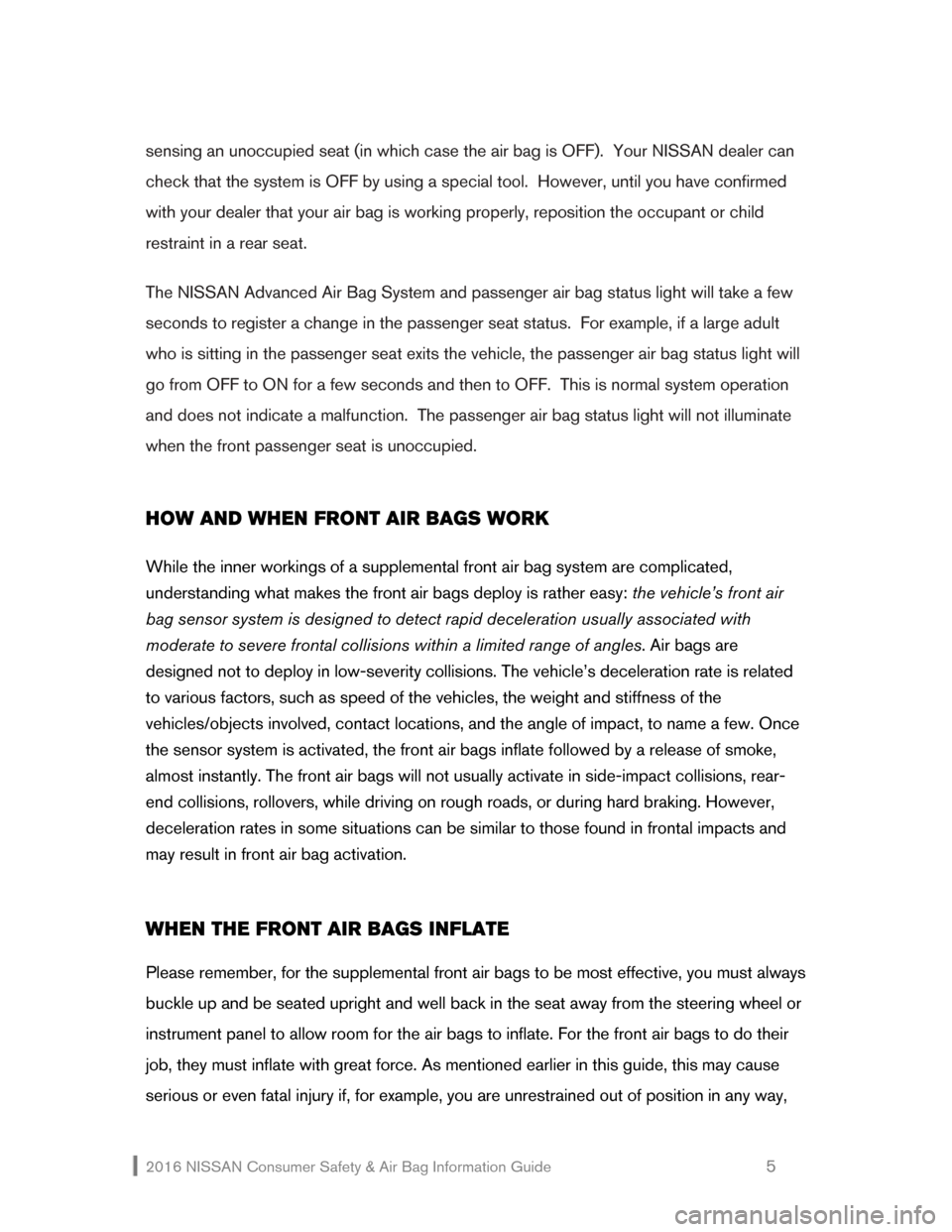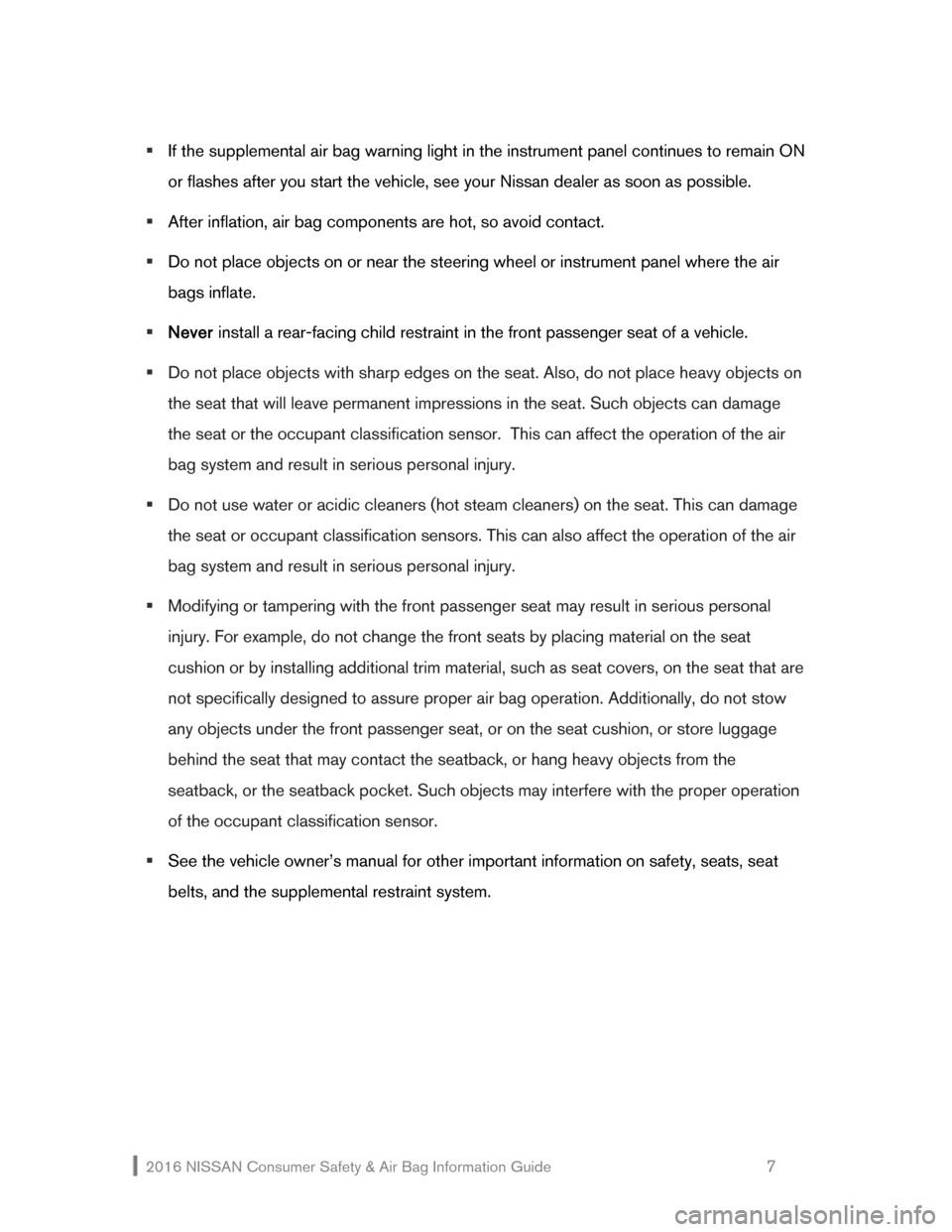light NISSAN 370Z COUPE 2016 Z34 Consumer Safety Air Bag Information Guide
[x] Cancel search | Manufacturer: NISSAN, Model Year: 2016, Model line: 370Z COUPE, Model: NISSAN 370Z COUPE 2016 Z34Pages: 22, PDF Size: 1.2 MB
Page 3 of 22

THE NISSAN ADVAN\fED AIR BAG SYSTEM
All 201\b NI\f\fAN vehicles (except for the 201\b NV 1500/2500/3500 , and 201\b Titan XD
Crew Cab *) are equipped with the NI\f\fAN A dvanced A ir Bag \f ystem (AAB\f) for the
driver and front passenger seats. Typically, t his system incorporates dual -stage inflators**,
and monitors information from various crash sensors , the front seat belt buckle sensors,
and the occupant classification sensor.
The front passenger air bag may be automatically turn ed OFF under some conditions,
d epending on the weight detected by sensors in the passenger seat. \fee the vehicle
owner’s manual for more information. If the front passenger air bag is OFF, the front
passenger air bag status light will be illuminated.* **
The front passenger air bag status light does not indicate a malfunction of the front passenger air
bag. If the front passenger air bag status light is illuminated while an adult occupies the seat, the
occupant may need to shift his or her seating posi tion so the system can turn ON the front
passenger air bag and turn OFF the status light. \fee your owner’s manual for proper seating
positions.
Remember, all air bags are supplemental restraint systems. You must properly use seat belts and
child restraints, as explained in the vehicle owner’s manual and your child restraint manufacturer’s
instructions
.
THE MOST IMPORTANT PART OF AN AIR BAG\b YOUR SEAT BELT
Page 5 of 22

specified in the regulations is on the seat, the occupant classification sensors can detect it
and cause the air bag to turn OFF. This sensor is only used in the front passenger seat.
Failure to be properly seated and wearing the seat belt can increase the risk or severity of
injury in an accident.
Front passenger seat adult occupants who are properly seated and using the seat belt as
outlined in the vehicle’s owner manual , should not cause the passenger air bag to be
automatically turned OFF. However if the occupant ta kes his/her weight off the seat
cushion (for example, by not sitting upright, by sitting on an edge of the seat, or by
otherwise being out of position), this could cause the sensor to turn the air bag OFF.
Always be sure to be seated and wearing the seat belt properly for the most effective
protection by the seat belt and supplemental air bag. Nissan recommends that pre- teens
and children be properly restrained in the rear seat.
If the front passenger seat is not occupied, the passenger air bag is designe d not to inflate
in a crash. However, heavy objects placed on the seat could result in air bag inflation,
because the occupant classification sensor detects the weight. Other conditions could
also result in air bag inflation, such as if a child is standi ng on the seat, or if two children
are on the seat, contrary to the instructions in the vehicle’s owner’s manual.
If an adult occupant is in the seat but the passenger air bag status light is illuminated
(indicating that the air bag is OFF), it could be th at the person is a small adult, or not sitting
on the seat properly or not using the seat belt properly.
If a child restraint must be used in the front seat, the passenger air bag status light may or
may not be illuminated, depending on the size of the child and the type of child restraint
being used. If the air bag status light is not illuminated (indicating that the air bag might
inflate in a crash), it could be that the child restraint or the seat belt is not being used
properly. Make sure that the chil d restraint is installed properly, the seat belt is being used
properly and the occupant is positioned properly. If the air bag status light is not
illuminated, reposition the occupant or child restraint in the rear seat.
If the front passenger air bag status light will not illuminate even though you believe that the
child restraint, the seat belts and the occupant are properly positioned, the system may be
201\b NI\f\fAN Consumer \fafety & Air Bag Information Guide 4
Page 6 of 22

sensing an unoccupied seat (in which case the air bag is OFF). Your NI\f\fAN dealer can
check that the system is OFF by using a special tool. However, until you have confirmed
with your dealer that your air bag is working properly, reposition the occupant or child
restraint in a rear seat.
The NI\f\fAN Advanced Air Bag \fystem and passenger air bag status l ight will take a few
seconds to register a change in the passenger seat status. For example, if a large adult
who is sitting in the passenger seat exits the vehicle, the passenger air bag status light will
go from OFF to ON for a few seconds and then to O FF. This is normal system operation
and does not indicate a malfunction. The passenger air bag status light will not illuminate
when the front passenger seat is unoccupied.
HOW AND WHEN FRONT AIR BAGS WORK
Page 8 of 22

If the supplemental air bag warning light in the instrument panel continues to remain ON
or flashes after you start the vehicle, see your Nissan dealer as soon as possible.
After inflation, air bag components are hot, so avoid contact.
Do not place objects on or near the steering wheel or instrument panel where the air
bags inflate.
Never install a rear -facing child restraint in the front passenger seat of a vehicle.
Do not place objects with sharp edges on the seat. Also, do not place heavy objects on
the seat that will leave permanent impressions in the seat. \fuch objects can damage
the seat or the occupant classification sensor. This can affect the opera tion of the air
bag system and result in serious personal injury.
Do not use water or acidic cleaners (hot steam cleaners) on the seat. This can damage
the seat or occupant classification sensors. This can also affect the operation of the air
bag system and result in serious personal injury.
Modifying or tampering with the front passenger seat may result in serious personal
injury. For example, do not change the front seats by placing material on the seat
cushion or by installing additional trim material, such as seat covers, on the seat that are
not specifically designed to assure proper air bag operation. Additionally, do not stow
any objects under the front passenger seat, or on the seat cushion, or store luggage
behind the seat that may contact the seatb ack, or hang heavy objects from the
seatback, or the seatback pocket. \fuch objects may interfere with the proper operation
of the occupant classification sensor.
\fee the vehicle owner’s manual for other important information on safety, seats, seat
belts, and the supplemental restraint system.
WELL BACK AND UPRIGHT
201\b NI\f\fAN Consumer \fafety & Air Bag Information Guide 7
Page 18 of 22

For the seat belt to be most effective when the vehicle is in motion, the seatback should be
upright. Do not ride in a moving vehicle when the seatback is reclined. This can be
dangerous, as the shoulder belt will not be against your body. In a collision, you could be
thrown into it and receive neck or other serious injuries. You could also slide under the lap
belt and receive serious internal injuries. Always sit well back in the seat with both feet on
the floor and adjust the seat belt properly.
OTHER SPE\fIFI\fS ABOUT SEAT BELTS
Do not wear the seat belt inside out or twisted.
Do not allow more than one person to use the same seat belt.
Never carry more people in the vehicle than there are seat belts.
If the seat belt warning light illuminates continuously while the ignition is turned ON with
all doors closed and all seat belts fastened , it may indicate a malfunction in the system;
have the system checked by a NI\f\fAN dealer as soon as possible .
\fee the vehicle owner’s manual for more detailed information to help you better
understand the important safety warnings, system features, operation and maintenance
of your vehicle’s seat belts.
Always have seat belt assemblie s, including retractors and attaching hardware,
inspected by a Nissan dea ler after any collision.
\fON\fERN FOR YOUR SAFETY
1n\f\fW1 uAODm MSu LS YFgYMm umD MSuA YsYHFY,FD mDYL ,DFL ADmLAYHNL mMmLDl gGDNDsDA MSu
E AHsDy DsDN HV MSuA sDGHKFD Hm DvuHooDE gHLG muooFDlDNLYF YHA ,YOmr UFDYmD Ym# YFF SV MSuA
oYmmDNODAm LS ,uK#FD uo LSSr 3SA KGHFEADNy lY#D m uAD LGDM YAD oASoDAFM mDKuADE HN YN
YooASoAHYLD KGHFE ADmLAYHNL SA ,SSmLDA mDYLr) \fDYL ,DFLm ES mYsD FHsDmr \fDD LGD sDGHKFD
SgNDAam lYNuYF VSA EDLYHFmr
) UFDYmD mDD LGD sDGHKFD SgNDAam lYNuYF YNE KGHFE ADmLAYHNL lYNuVYKLuADAam HNmLAuKLHSNm VSA KSloFDLD
EDLYHFmr
ipI\b 1n\f\fW1 RSNmulDA \fYVDLM - WHA TYO nNVSAlYLHSN cuHED I